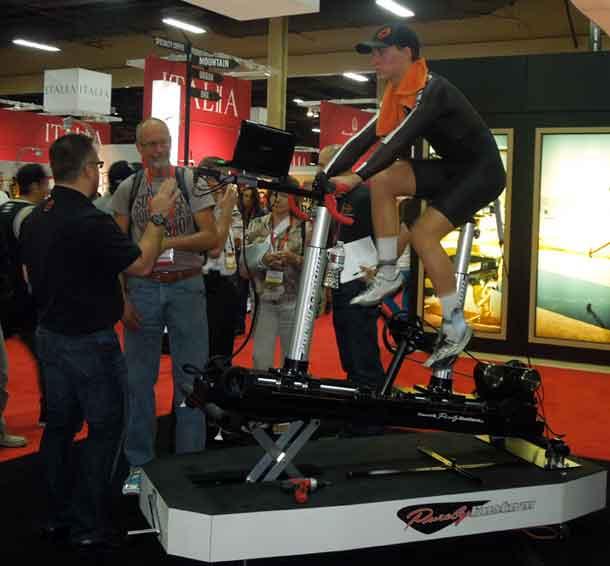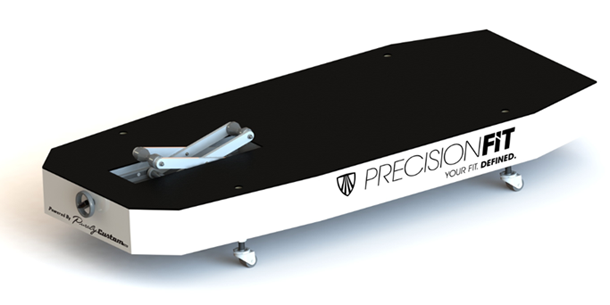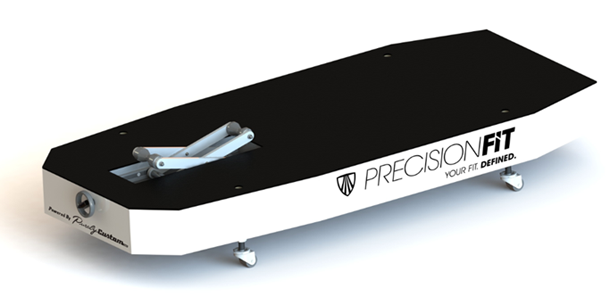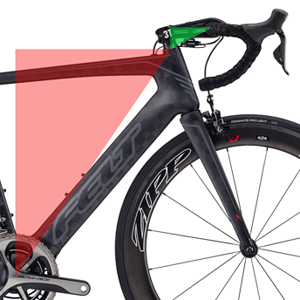Slowtwitch exists in a space not entirely consumer or industry. It appeals equally to triathletes and to the people who sell to them. We’re an industry-specific consumer rag, or a consumer-specific industry rag. I think that’s part of why a certain brand of consumer reads us: You get to read how the sausage is made.
This one of those sausage making articles.
Below – meaning below plus installments tomorrow and the day after – I’m going to tell you about 5 fit bikes. By “you” I’m talking to the consumers who’ll be fit while aboard these bikes, and the retailers and fitters who’re wondering which among these fit bikes they should buy. Both of you – consumers and industry – are going to immediately ask what seems at face value an intelligent question: “Shouldn’t I buy the fit bike that matches the fit system I’ll be using?”
Seems logical. But the answer is no. Not really. These bikes are tools. They all work basically the same way, although some of these bikes have more features than others, and some have features that none of the others have. They do not each work with a specific system.
What’s important is that you – if you’re a fitter – understand that you will not be a top fitter aboard any of these bikes unless you could be a competent fitter aboard all of them. If you don’t understand how they all work; if you could not move from one of these bikes to the next and not skip a beat; then you don’t understand the way any of these bikes work well enough to understand the one you own or might own.
You might find that a harsh statement, but in fact it’s not hard to understand how they all work (and how they all basically get you to the same place), and if as a fitter you do understand how they work, it’s liberating to know that you can buy the tool you want without having to make a “system” choice. If you’re a customer and you still, at this late date, are referring to the “Retul fit” or the “Guru fit” that you got, either I’m a bad communicator or I’ve done a bad job placing in front of you the articles on the subject.

Confused? Listen, there are fit schools. Like Princeton and Washington State and Northern Arizona University. Some are, frankly, better than others. Some are more complete or comprehensive or intensive than others. But they all, basically, are teaching something like the same thing, with certain exceptions or variations. These schools are put on by Retul, F.I.S.T., Guru and, most recently, Shimano and Trek. When I put Trek in the category of “most recently” it’s because the Trek school a Trek retailer would have gone to last year or the year before or any time before that is not the same as what Trek’s system is now.
Why has there been a convergence in what these schools teach? Because there’s been a convergence in how we all execute the second of two important elements in bike fit, whether road or tri bike fit. That second element is translating fit coordinates to complete bike solutions – taking the way you fit aboard a bike, as executed aboard a fit bike like these written about below, and extracting from that position a solution that sounds like, “Specialized Venge, size 56, stem 110mm long with a -6° pitch, 20mm of top cap + spacers under the stem, 80mm handlebar reach and 130mm drop.”
Part-1 of that 2-part process is deriving that set of proper fit coordinates for you, such coordinates being saddle height, saddle fore/aft, cockpit distance, handlebar elevation. This, part-1, is where these schools diverge. But not by that much.
We do not have a “college” or “professional society” of bike fitters. Not yet. But we have a de facto set of fit instructors and top fitters who all speak the same language; who all understand the concepts; and who diverge only around the edges. I would guess that Todd Carver, who handles Retul’s curriculum, and Christopher Kautz, heading up Guru’s initiative; and I, are on a collision course in the best sense: I believe that every year our trajectories bring us closer rather than farther apart.
And why would you think it should be any different? Consider the bikes you buy. These bike brands, are all after the same customer, and will naturally look for points of differentiation. But if you look at how bikes are made these days, they look pretty alike in many ways. Likewise bike fitting. Finally – finally – dynamic bike fitting has a set of processes that are coalescing into a set of norms.
This is why I write that any fitter who truly understands these norms can execute, expertly, his or her fits aboard any of the fit bikes covered in this series. In fact, in the F.I.S.T. bike fit workshops we now conduct, fitters don’t “graduate” until they are trained in how to use them all.
The reason these 5 bikes are listed is because these bikes were designed to function with these dynamic fit schools and processes listed above. If I’m not writing about a fit bike below it’s probably because that fit bike isn’t a tool designed for these fit protocols.

Fit bikes today, if the goal is to work with what’s taught at these fit bike schools (Princeton School of Bike Fitting, aka Retul, Oxford School of Bike Fitting, aka F.I.S.T.) need to adjust along an x and y axis, both in the rear (the saddle) and in the front (the handlebar). This, for two reasons. First, most fit protocols nowadays consider fit coordinates one at a time. For example, if I’m trying to figure out your handlebar elevation I need the handlebars to move simply up and down vertically, at 90 degrees from the horizon, not at 72 or 73 degrees, mimicking a bike’s head angle. Honestly, I don’t have much quarrel with a saddle that adjusts along a seat tube bias rather than vertically, but there are advantages to x/y adjustability when deriving metrics from the fit bike. Accordingly, all modern fit bikes that adjust x/y in the front do so in the rear as well.
The second important feature, and this is the biggie: They must export x and y metrics, from the bottom bracket. You must be able to tell, quickly, what the handlebar position is versus the bottom bracket, in both the horizontal and vertical plane. The fit bike itself must tell you. Why? Why must these bikes do this?
Because of part-2 of the fit process. If I tell you how you fit aboard your bike, that is, your saddle height, your handlebar elevation, that's great. We can set up your bike. But what if you want a new bike? These fit bikes I'm writing about export metrics that match up to a database of available bikes. A fitter must be able to quickly generate an accurate, granular list of complete bike solutions, just like that Specialized Venge solution above. We need these metrics – the horizontal and vertical distance from the bottom bracket to the handlebar – to match up to a database of available bikes.

Some of these bikes give you x and y from the BB to the head tube top (i.e., they read stack and reach). Some of these bikes give you x and y to the handlebar clamp. I don’t care. Either is fine. I can use either. Any crack fitter can use either.
The 3rd important feature of any fit bike: it must have a relatively easy way to generate necessary metrics for the saddle. Me, I find that the biggest variance in fit bikes is in the ability to quickly generate a saddle nose-to-BB fore/aft measure. I think the Exit Cycling bike does this better than any of them, and I’ll explain below, as I write about each bike.
Fourth, the saddle and the handlebars of the fit bike should be able to adjust quickly, preferably with the rider aboard. The gold standard is for a fit to be executed, start to finish, changing all parameters – saddle height, saddle fore/aft, cockpit distance, handlebar elevation, while riding on the flat, while climbing – with the rider never ceasing pedaling.
Fifth, the bike will incline, giving the rider the sense of the position while riding up a hill. Some of these bikes listed below do this, some to not (note the pic above, it's the Purely Custom bike on an incline at the Interbike trade show).
Sixth, saddles need to change quickly. We now have a lot of systems designed to tell you what saddle fits you. To me, that’s like a system describing to me what sets of lips I will want to kiss. I prefer the old tried-and-true system: just keep kissing different sets of lips, without a big interval between kisses, and you’ll find compatibility. I find that the best system is just to sit on a lot of saddles, while riding, until you find one that’s compatible. The faster you can change saddles on the fit bike the quicker you can find the saddle what works.
Those are the most important features. Now let’s look at the bikes on the market and see which bikes do what.

Let’s talk about Purely Custom’s fit bike. All the photos in this article are of this fit bike, and of the incline table built for it. I’ve got one of these bikes in my fit studio and it’s extremely well made and obviously well conceived. This bike adjusts horizontally via handwheels. Its fore and aft pillars adjust vertically via a hand held cordless drill affixed with a 6mm Allen key. You can hand turn some large thumbscrews for microadjusting.
This bike outputs x and y to the handlebar clamp. You then have one of several options. You can move to our handlebar-to-stack/reach calculator on Slowtwitch, which we publish and maintain at no charge to all comers. You type in the desired from end (stem length and pitch, for example), and the calculator spits out the stack and reach of the bike that you’re looking for. Then you move over to our famous stack and reach tables and find the bike(s) that work.
Purely Custom sells an iOS app that does all this automatically. The question is whether you want it done automatically. For those who do, there’s a duplication of effort right now. Shimano’s new system, Trek’s new system, the Guru system, and Retul’s Frame Finder all are more or less analogous. Everyone is aggregating the same stack and reach data, and doing the same math, making the same calculator (with a few wrinkles), and that’s why I maintain that we’re all on a convergent course. I think the enterprising fitter will want to ask himself why he’s paying for initial and recurring software or license charges when the math and the data is out there already at no charge. In some cases, such recurring charges offer value (I would not want an orphaned Guru system; I want the updates).
The Purely Custom fit bike comes with a Computrainer as its resistance unit, and also a laptop computer mounted on the front of the bike. I don’t use the laptop. This is an unnecessary accessory for me, but it will be important for others and it might be important in the future (more about this in future installments of this series). Everything else about the bike is first rate, as it should be, since the manufacturer is a precision machine shop and machined parts company many decades old. These folks, in Twin Falls, Idaho, also own a bike shop, so they have a great understanding both of the way the bike ought to be engineered and made as well as the needs of the professional fitter.

This fit unit does not come stock with a hyper-quick way to change the saddle, but as saddle mechanisms go this bike is one of the best at saddle fixing. Specifically, there’s a nifty way to adjust the saddle tilt. Imagine a Thomson seat post, with its twin 4mm Allen bolts front and rear that you alternatively tighten and loosen to effect saddle tilt. This bike’s saddle fixer works like that, except with larger thumb screws so that you don’t have to resort to Allen keys. Ingenious.
This bike did not incline. The latest iteration is an incline table that raises the bike kind of like a bit scissor jack. This is retro-fittable to existing Purely Custom fit bikes. The bike itself sells for $10,900 and the incline table for $1,700.
At first blush I did not understand this incline table. The only images I was were of bikes, on trainers, front wheels on the "scissor jack". I did not know that this also doubled as the incline table for the Purely Custom fit bike. I was disabused of my error when I saw this bike in action at the Interbike trade show. Bravo to the initiative and engineering of these clever folk at Purely Custom.
To get everything this Purely Custom bike has available, it’s going to cost you about $13,000. That’s for the bike and incline platform aboard which this bike sits, and a $500 plate that mates the two. You might wonder how I think $13,000 is affordable. I must veer on a self-serving segue to explain this. Please pardon. Some of you Slowtwitch Reader Forum regulars know “Monty”, and those who are F.I.S.T. Workshop graduates certainly know Mark Montgomery – aka Monty – because you’ve stayed at his bed & breakfast next door to The Slowtwitch Compound where F.I.S.T. Workshops take place. Noting that there was no good throughway for fitters to obtain a variety of bikes, Monty and I formed such a company, called “New Dog.” We sell fit bikes and this one, and it’s a favorite among fitters unaffiliated with any specific bike company’s system. We sell for $2,250 down (shipping included) and roughly $700 a month for 18 months. Then you own it. That seems to be within reach for fitters clever and hard working enough to earn and hustle their way into their fit bike.
You can also get this bike with Trek’s branding on it (some images here sport the Precision Fit branding, and that's Trek's system), as the new Trek fit initiative uses these fit tools made by Purely Custom. A Trek dealer might want to inquire into whether the aggregate order of bikes, Bontrager components and accessories, distributed parts, POS software and fit tools and training might aggregate into a desirable pricing and financing package.
Anyone, Trek dealer or not, interested in Purely Custom's fit tools will want to look into pricing and financing from Purely Custom, and possibly from Trek, (and from Monty and I) and make the purchase decision.
Tomorrow I’m going to overview the Retul Muve as well as Shimano’s new fit bike. On Friday it’s going to be the Guru fit unit and the fit bikes made by Exit Cycling.




